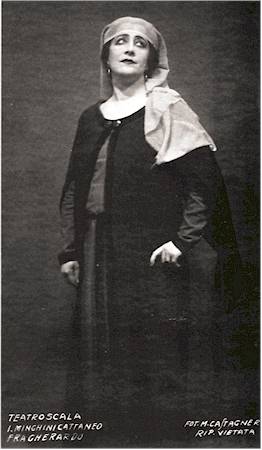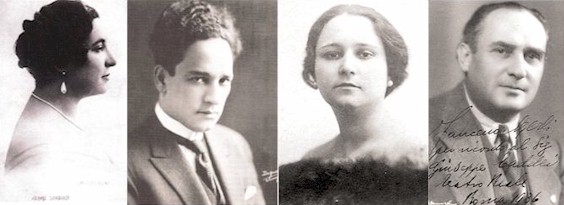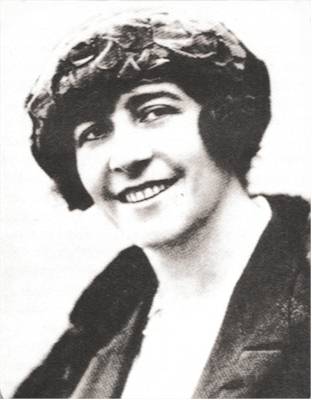Italian mezzo-soprano, 1892 - 1944
(by courtesy of Charles B. Mintzer) Biographical notes:
She was born at Lugo di Romagna near Ravenna and was encouraged at the age of 14 to pursue a musical career. She received her first instruction from Maestro Cicognani, later from Ettore
Cattaneo whom she married in 1920. He was not only her voice teacher and adviser but also director of the music publishing house Ricordi in Milan. It was Giacomo Lauri-Volpi who posed the
question why Irene never became a singer with an international career. On the one hand the artist had to take into consideration the position of her husband, and therefore renounced a
totally independent career for herself. On the other hand she was described as a “difficult” character. Her debut took place at Milan’s Teatro Carcano as Madelon in Giordano’s Andrea
Chénier in 1918, soon to be followed by Amneris, her favorite and most acclaimed role. Within a short time she succeeded as Amneris, Azucena, Adalgisa, Eboli, La Cieca, Dalila, Laura, Elena,
L’Innocente (L’Arlesiana), Preziosilla, Giglietta in Mascagni’s Isabeau, Madelon, Maddalena, Ulrica and Mrs. Quickly at all the leading Italian theatres. In 1928 Irene debuted as Amneris at Covent Garden opposite Dusolina Giannini and Aureliano Pertile. She added Marina (Boris Godunov) to her repertory and sang the role with Feodor Chaliapin and Margherita Carosio. However, her reviews were less kind, complaining of a much too broad Italianate approach. It
was in Italy, Germany, Spain, Egypt and Greece she gained great success (she never sang in South America as often claimed). It was again at Covent Garden that she had the opportunity to appear opposite Rosa Ponselle, in La Gioconda and Norma. The two ladies did not get along at all
behind the curtain but the comment by the critics was that “in Madame Cattaneo was found a mezzo soprano whose rich tones could both contrast and combine those of Ponselle.”
Occasionally, she even performed Brangäne and Ortrud (to Beniamino Gigli’s Lohengrin). The artist bade farewell as La Cieca in 1941. She died on March 24, 1944 in her villa in Rimini, the
victim of a bombing attack by the Allied forces.
As Mariola in Ildebrando Pizzetti’s “Fra Gherardo” “What a wonderful voice and temperament that woman had. I will always remember her duet with Giannina Arangi-Lombardi in the second act and her scene with Antonio Cortis in the last act. There existed some sort of rivalry or competition between the admirers of Arangi-Lombardi and Minghini-Cattaneo [the two women were friends] and the storms of applause after each passage sung by the said singers lasted for minutes.” Dr. Garcia Montes about a performance of Aida in the Arena di Verona, The Record Collector, 1927
Some of Irene Minghini-Cattaneo’s most frequent partners
Giannina Arangi-Lombardi * Antonio Cortis * Rosetta Pampanini * Francesco Merli
Comment:
Irene Minghini-Cattaneo is certainly to be counted among the most appreciated Italian mezzo sopranos. Hers is a vibrant voice of an arresting sound after the “modern Italian fashion”, with
amazing extension at both ends of the range (chest register!). Her legato line is frequently disturbed by quite a strong vibrato. Compared to two of the most prominent Italian mezzos, Gabriella Besanzoni and
Cloe Elmo, she is neither a singer of great subtility nor a much
convincing exponent of florid singing (Bellini, Donizetti). However, the power of the voice and her dramatic instincts and passionate singing can be truly breathtaking, above all, in Verdi and
veristic operas (listen to the sound clip). She participated in two landmark recordings, in Aida and in Il Trovatore in which, at least to me,
she is the outstanding artist of each (both performances have transpositions, cadenzas are simplified). I would like to mention here that Gino Nastrucci conducted the greater part of the
recording, and not Carlo Sabajno, as often claimed.
Many thanks to Charles B. Mintzer
|
|||||||||||||||||||||||||||||||



